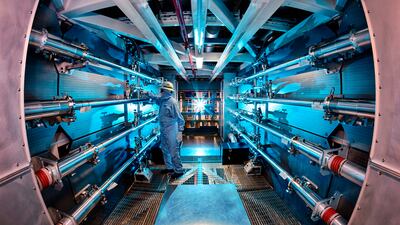The US Department of Energy on Tuesday announced that researchers had achieved a major breakthrough in nuclear fusion, which could possibly be a revolutionary power source.
Energy Department Secretary Jennifer Granholm heralded the perseverance of scientists at the Lawrence Livermore National Laboratory in California for not losing sight of their goal despite the struggles and setbacks they faced.
“This is a landmark achievement for the researchers and staff at the National Ignition Facility who have dedicated their careers to seeing fusion ignition become a reality, and this milestone will undoubtedly spark even more discovery,” Ms Granholm said in a statement.
Ms Granholm and other US officials said the achievement is a major step forward in advancements for national defence and clean power. President Joe Biden has set a 10-year goal to create a commercially viable fusion generator.
“This is game-changing, world-improving, lives-saving history unfolding in real time. Absolutely astonishing," Ms Graholm said.
Nuclear fusion is considered by its supporters to be a clean, ample and safe source of energy that could one day allow the world to reduce its dependence on other sources of energy that are driving the climate crisis.
Scientists made the breakthrough on December 5.
The laboratory used 192 lasers to trigger the reaction, focusing enormous heat on a small spherical capsule the size of a peppercorn. The temperature was more than 3,000,000°C.
The reaction produced roughly 2.5 megajoules of energy compared with the 2.1 megajoules used to power the lasers, a net energy gain.
It is an “engineering marvel beyond belief”, Ms Granholm said.
“This is an amazing example of the power of America's research and development enterprise.”
The breakthrough is also an achievement for the White House, which has provided federal funding for research and development.
Beyond the Headlines: can nuclear fusion save the planet?
“It is an enterprise that [President Joe] Biden has championed in a way that no one really ever has before,” said Jill Hruby, Under Secretary for Nuclear Security and National Nuclear Security Administration (NNSA) Administrator.
The Department of Energy said the experiment is a “game-changer” for Mr Biden's goal of creating a net-zero carbon economy.
Nuclear power plants currently use fission, which differs from nuclear fusion in that it involves the splitting of a heavy atom's nucleus. Fusion, meanwhile, combines light hydrogen atoms to create on heavier atom, which produces an extraordinary amount of energy.
This is the same process that occurs inside stars. Scientists have known for close to a century that fusion powers the sun, but the process to attain a similar achievement has taken decades.
“And in that century, it took so many different kinds of advances that ultimately came together to the point that we could replicate that fusion activity and this in this controllable way in a laboratory,” White House science adviser Arati Prabhakar said.
Ms Prabhakar added that the road it took to achieve this milestone is a reminder that it can be a long time before humanity turns that kind of knowledge “into something that we can actually harness and start to use”.
Tests typically require a significant amount of power. Previous efforts to create a fusion reaction resulting in a net-energy gain proved elusive.
Proponents of fusion hope that it could one day produce nearly limitless, carbon-free energy, displacing fossil fuels and other traditional energy sources. Producing energy that powers homes and businesses from fusion is still decades away. But researchers said it was a significant step nonetheless.
Supporters of nuclear fusion hope that it could one day replace fossil fuels and other traditional energy sources, producing an abundant carbon-free economy.
“This astonishing scientific advance puts us on the precipice of a future no longer reliant on fossil fuels but instead powered by new clean fusion energy,” said Senate Majority Leader Chuck Schumer.
Making this kind of technology commercially viable is still decades away. Should it be commercially available, it could create a net-energy gain without the risk of nuclear disaster or producing radioactive waste.
Kimberly Budil, the director of Lawrence Livermore, told reporters that commercialisation of nuclear fusion is not five or six decades away, but sooner.
“I think it's moving into the foreground and probably, with concerted effort and investment, a few decades of research on the underlying technologies to put us in a position to build power plants,” she said.
Agencies contributed to this report

